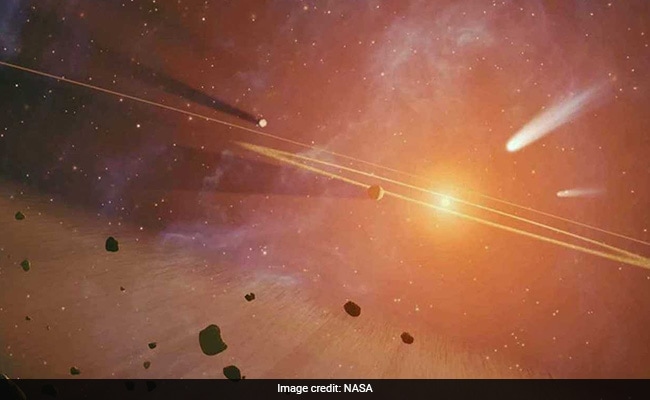INSUBCONTINENT EXCLUSIVE:
An illustration of the early solar system, when the Almahata Sitta meteorite may have existed
Ten years ago, an Arizona astronomer spotted an asteroid that was
headed straight for Earth
Swiftly he summoned the help of colleagues and casual stargazers, who tracked the space rock as it exploded in the sky, raining shrapnel
down on the Nubian desert in Sudan
Students from the University of Khartoum volunteered to search for fragments, ultimately recovering more than 600 pieces of the meteorite
now known as Almahata Sitta
It was the first time scientists had ever traced an asteroid in the sky to a rock they could hold in their hands.But that is not even the
coolest thing about Almahata Sitta
Not nearly.A new study published in the journal Nature Communications reports that the meteorite contains tiny diamonds - yes, diamonds
Those diamonds contain even tinier impurities called inclusions
And within those inclusions are signatures of a long-lost planet as large as Mars - a 4.5 billion-year-old relic that was destroyed during
the earliest days of the solar system."These samples are coming from an era that we don't have any access to," said Farhang Nabiei, a
materials scientist at the Swiss Federal Institute of Technology in Lausanne and the lead author of the new report
The diamonds with the Almahata Sitta meteorite formed during a transition era in the solar system, when the dust and gas that swirled around
the sun coalesced into planetary embryos, then grew into planets."And we are part of the planets," Nabiei said
"This is part of the story of how we came to be.Almahata Sitta belongs to a class of rocks known as ureilites
They are partly differentiated - not made of the primitive material that constituted the solar nebula, but also not as well mixed and baked
as rocks that come from modern planets
Unlike other meteorites, which can be traced to parent bodies such as asteroids, Mars or the moon by comparing the ratios of different
varieties of elements, these rocks have no known source
They seem to have been formed inside bodies that no longer exist.And they always contain tiny flecks of diamond.Because the crystals are so
small - less than a fraction of a percentage of an inch in diameter - many researchers assumed that they formed when graphite (an alternate
form of carbon) was "shocked" by a collision with another body
But Nabiei and his colleagues noticed that the diamonds in Almahata Sitta were orders of magnitude larger than the kind that result from a
They suspected that these crystals may have formed the same way diamonds do on Earth - under the unbelievably high temperatures and
pressures that exist in the interior of a planet - and only afterward were broken by a shock wave into smaller fragments."Then this opens
whole new idea," Nabiei said
Diamond is so strong it serves as a powerful protective packaging for anything trapped inside; it's nature's safety vault, capable of
preserving samples for billions of years."I thought, if there were diamonds forming inside a planet, inside a parent body, they could have
trapped some material from their environment," Nabiei said
"And indeed they did."The impurities trapped within the Almahata Sitta diamonds - crystals of chromite, phosphate and iron-nickel-sulfide -
are the first to have been discovered in an extraterrestrial diamond
They could only have formed under incredible pressure - the equivalent of diving 600 kilometers into Earth's interior or attempting to hold
up 100,000 tons with your bare hands.To create these conditions, Nabiei said, the meteorite's parent body would have to have been a planet
at least as big as Mercury and possibly as large as Mars.Whatever happened to this lost world Nabiei can't say for sure
Many researchers believe that the early inner solar system was crowded with large protoplanets that yanked and tugged at each other's orbits
until they finally crashed, coalesced or disintegrated
By the end of that era, about 100 million years after the birth of the solar system, only the four current terrestrial planets
remained.Nabiei thinks it's likely that all ureilites come from the same parent body, a protoplanet that lasted just a few million years
before it was destroyed in a collision
He plans to seek out similar meteorites and search them for inclusions that might provide clues about their origins.(This story has not been
edited by staff and is auto-generated from a syndicated feed.)

